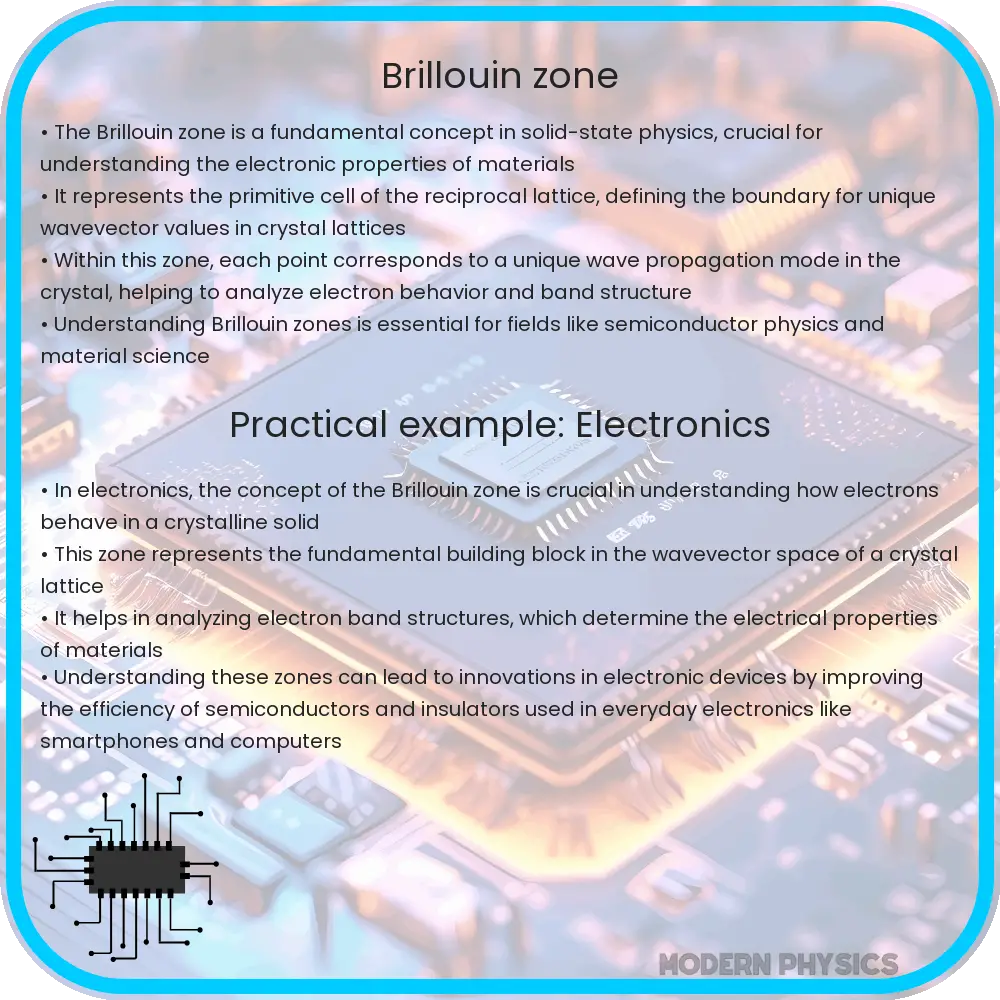Explore the Brillouin Zone’s pivotal role in solid state physics, from analyzing electron behavior to its impact on material and device design.

Understanding the Brillouin Zone in Solid State Physics
The Brillouin Zone is a fundamental concept in the field of solid state physics, playing a crucial role in the analysis of wave propagation in periodic structures. It represents the reciprocal space within which the entire set of possible wave vectors that define the states of electrons in a crystalline solid can be uniquely described. This concept is instrumental in understanding the electronic properties of materials and has significant implications for the study of crystal lattices, band structures, and electronic band gaps.
Key Concepts Behind the Brillouin Zone
At the heart of the Brillouin Zone concept is the reciprocal lattice, a mathematical construct used to describe the periodicity of a crystal in momentum space. The reciprocal lattice is generated from the direct lattice of the crystal by a Fourier transform, and it provides a framework for understanding electron diffraction patterns and the electronic structure of materials.
- Construction of the Brillouin Zone: The first Brillouin Zone is constructed as the Wigner-Seitz cell in the reciprocal lattice, which is the region of space closer to a given lattice point than to any other. It serves as the primitive cell of the reciprocal lattice and is essential for the analysis of electron behavior in solids.
- Band Structure Analysis: The energy levels of electrons in a crystal are described by band structures, which can be mapped within the Brillouin Zone. This mapping reveals the allowed and forbidden energy levels for electrons, aiding in the prediction of material properties such as conductivity and optical characteristics.
- Role in Phonon Dispersion: The Brillouin Zone also finds application in the study of phonons, or quantized lattice vibrations, which affect the thermal and mechanical properties of materials. By analyzing phonon dispersion relations within the Brillouin Zone, scientists can predict phenomena such as thermal conductivity and sound velocity in solids.
The utility of the Brillouin Zone extends beyond mere theoretical constructs, influencing practical applications in the design of electronic and photonic devices, such as semiconductors and solar cells. By enabling a deeper understanding of the electronic structure of materials, the Brillouin Zone concept helps scientists and engineers tailor material properties for specific applications, marking its significance in the advancement of technology and materials science.
Understanding the Brillouin Zone in Solid State Physics
The Brillouin Zone (BZ) is a fundamental concept in the field of solid state physics, playing a crucial role in the analysis of wave propagation in periodic structures, especially in crystals. It is named after Léon Brillouin, who introduced the concept in the early 20th century. The BZ represents the primitive cell in reciprocal space, which is the Fourier transform of the real space lattice of a crystal. Understanding its structure and properties is essential for analyzing electron behavior in solids, phonon dispersion, and the overall electronic structure of materials.
At its core, the Brillouin Zone is defined by the set of points in reciprocal space that can be reached from the origin without crossing any Bragg plane. These planes are defined by the diffraction condition, which describes how waves scatter off the regular arrays of atoms in a crystal. The first BZ is the most significant because it contains all the unique information about the crystal’s band structure, which describes the ranges of energy that an electron within the crystal can have and those it cannot.
One of the key uses of the BZ in solid state physics is in the analysis of electron behavior. Electrons in a crystal feel the periodic potential of the lattice, leading to the formation of energy bands. The BZ helps in visualizing and calculating these bands, especially through the application of Bloch’s theorem. This theorem states that the wave functions of electrons in a periodic potential can be expressed as a plane wave multiplied by a periodic function. The implications of this for conductivity, semiconductor physics, and the properties of metals are profound.
Application and Significance
The practical applications of understanding the Brillouin Zone are vast. In semiconductor physics, for example, the BZ is used to determine the effective mass of electrons and holes, which in turn influences the conductivity and performance of semiconductor devices. Additionally, in the field of photonics, the concept of photonic crystals relies heavily on the analysis of the photonic band gap, which can be determined using the BZ. This has implications for the design of optical devices, including lasers, waveguides, and sensors.
Furthermore, the analysis of phonons, or quanta of lattice vibrations, also makes use of the BZ. Phonon dispersion relations, which describe how the frequency of phonons changes with their wavevector, are crucial for understanding thermal conductivity and specific heat in solids. The BZ provides a framework for visualizing these relations and understanding the interactions between phonons and electrons, which can lead to phenomena such as superconductivity.
Conclusion
The Brillouin Zone is a cornerstone concept in solid state physics, offering deep insights into the behavior of waves in periodic structures. Its applications extend from fundamental physics to practical engineering, influencing the design and understanding of materials and devices in electronics, photonics, and beyond. By enabling the analysis of electron and phonon behavior in crystals, the BZ helps scientists and engineers design better semiconductors, lasers, and other key technological components. As research advances, the importance of the Brillouin Zone in unlocking the secrets of material behavior at the quantum level continues to grow, highlighting its enduring relevance in the advancement of science and technology.
